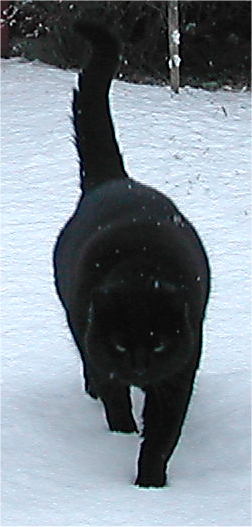Why are black cats black?

A black cat attracts very little attention, except from the superstitious. In northern Europe they are generally considered unlucky , while most Mediterranean cultures consider them lucky; and at the end of this article, we give you the scientific verdict on which opinion is correct.
First of all, note that black cats are mutants. This is not particularly alarming, as mutations are part of evolution, and if cat fur colours did not mutate, cats would all be stuck with their original colour scheme, which was tabby. In fact if you look at a black cat in the sunshine, you can sometimes make out the faint rusty stripes of the ancestral coat colour.
The colour of a cat's skin, eyes and hair depend on the juggling of interlinked genetic sets, just as with humans. The question is where an individual’s genetic code has decided where pigment-producing cells are going to end up, and how hard these cells are going to work. (These cells are called melanocytes, and most humans and cats have these in their hair, eyes and skin. It’s how many and how-hard working melanocytes are that determines human skin colour. ) With hair, melanocytes produce a particular colour depending on the proteins which they receive from the body.
Feline skin melanocytes should usually get a protein called agouti, which which prompts the production of a yellow-brown pigment. This is why the default colour of wild cats is tawny. Domestic felines would also be tawny, if not for humans fiddling with their genes to get different colour combinations. These combinations also happen naturally, as we see with yellow and black animals such as tigers, leopards, and indeed, tabbies.
Yellow and black combinations happen because sometimes the agouti protein does not have the correct number of folds and the melanocytes do not recognize them. In the absence of the ‘proper’ protein, the melanocyte pigment-producing cells latch on to another protein, which tells them to produce a very dark brown colour. Because the protein is produced near to the melanocytes, if strips of skin produce faulty agouti proteins, then the cat will have dark stripes. If clumps of skin produce faulty agouti, the cat will be spotted (as a leopard) or piebald (as with a black-and-white cat).
In evolutionary terms spots and stripes have been a great advantage for some cats. It is no co-incidence that spotted cats have been most successful in forested areas, where the pattern of their pelts mimics the shadow of leaves. Tigers meanwhile evolved so that their stripey skins merge them into bamboo and long grass, while the lions of the savannah get no evolutionary advantage from being two-toned and keep the original colour scheme.
Black cats are the result of the aguoti protein production going awry right across the pigment producing area. This is because a part of the feline gene is missing in these cats, and consequently the agouti proteins are too short to be recognized at all by the pigment-producing melanocytes, and the result is a pelt which is black all over. Oddly enough black panthers and tigers also benefit from a uniform colour scheme, simply because in the wild these animals are relatively rare, and prey are less likely to look out for them.
Some scientists believe that the mutation which causes agouti production to fail altogether is a by-product of another evolutionary development. This mutation is so common, especially in felis felis (the domestic cat) that it is believed that in the past a virus once attacked the feline population with particular ferocity. Some viruses work by incorporating themselves into the host body’s DNA. Because black cats had a defective gene, this particular virus was unable to work on them, causing many more black cats to survive than their tawny or two-tone relatives.
So it's official - black cats are definitely lucky.

